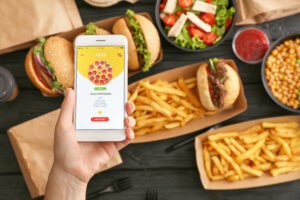Mobile advertising is changing the game for industries across the consumer spectrum. One of the more surprising industries getting a bump is the quick service restaurant (QSR) industry. Mobile advertising has become a potent strategy for driving sales for QSRs. This is largely due to the shift in consumer behavior that has come with the digital age. Now that many consumers in today’s marketplace expect, and even prefer, digital interaction with their favorite QSRs, mobile advertising is becoming more effective than ever before. According to a BIA Advisory Services report, QSRs have increased their mobile ad budgets in 2020 by $134 million compared to last year. That’s because it works.

Here are some examples of how mobile advertising is driving sales in the QSR Industry.
Leveraging Location
Geofencing and geolocation technology allows QSRs to serve targeted mobile ads to consumers in a specific location as big as a zip code or as small as a few hundred square yards. This means that they can get strategic with who they are targeting with a particular message. For example, a QSR that’s also offering delivery can send walk-in deals via a mobile coupon for consumers that are close to their location and delivery deals to users that are further away. They can also use geoconquesting to fence their competitors to build brand awareness and try to convert their competition’s customers. See restaurant case study here.
Moment Based Interaction
If targeting a specific area is good, doing it with a time frame in mind is better. QSRs are using mobile to advertise time sensitive menu items and “meal deals” for certain days of the week to create urgency and incentivize the potential customer to visit sooner rather than later. The geolocated ads can be served through the QSRs mobile app or across multiple other apps that consumers use when they are in a specific area. This is particularly effective when based around an event, holiday, or season. It’s also great for re-marketing to customers with rewards, points, or deals to get them to come back. See time based case study here.
Data Capture
One of the biggest benefits of any mobile advertising is the ability to track effectiveness with click through and conversion rates. When combining the technology of geofencing with targeted mobile ads and the data that it generates, QSRs can make smarter decisions about what ads, deals, and menu items work best for driving traffic and earning business.
Consumer-Brand Interaction
Not only do mobile ads drive sales on their own, but they can also stimulate the types of consumer-brand interactions that lead to additional sales. For instance, when a customer comes in for a meal, brands can offer them a future deal in exchange for a review or social share that will drive additional sales.
Mobile technology is continuing to remove barriers for QSR consumers. They can now order and pay on a mobile app or website, instantly notify a QSR that they’ve arrived for curbside pick-up, and leave a five-star review – all while on-the-go. Connecting with that on-the-go market and earning their business might seem difficult, but new technology in mobile advertising is helping QSRs stay ahead of the curve.

